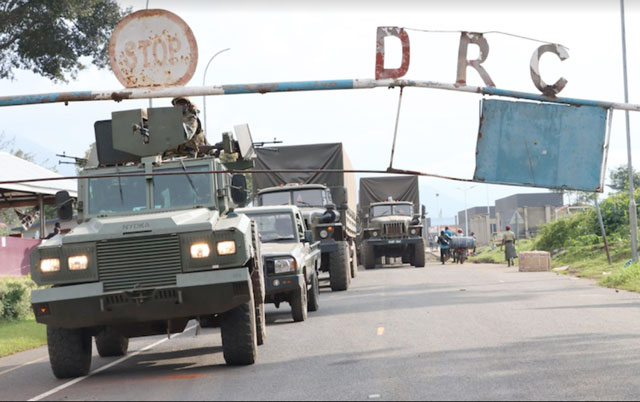
New enemy with 40,000 fighters rises
Kampala, Uganda | THE INDEPENDENT | The Uganda Army is once again locked in a propaganda war of words with armed fighters in the DR Congo who claim it is siding with rebels fighting the Kinshasa government.
This time those accusing the UPDF call themselves the “wazalendo”, meaning “patriots” in Kiswahili. According to reports from the DR Congo, the so-called Wazalendo is a carry-all reference to any of the numerous armed vigilante groups that have sprung up since President Félix Tshisekedi in November 2022 called on all able-bodied civilians in eastern DR Congo to take up arms and fight against what he called “the expansionist ambitions” of the M23.
So Wazalendo can refer to any of the vigilante groups like the Forces d’Action Rapide (FAR), Mazembe Mayi-Mayi, Congolese Revolutionary Movement (MRC), the Alliance for a Free and Sovereign Congo (APCLS) and more.
According to reports, there are over 100 such militia groups in eastern DRC, including many that previous fought the government forces called Armed Forces of the Democratic Republic of Congo (FARDC) but are now allied to them. The Wazalendo is also sometimes associated with a mystical-religious sect called Uwezo wa Neno.
This new coalition of myriad militia groups is said to have up to 40,000 fights in its ranks and it is now the self-declared enemy that the UPDF must reckon with.
Civil society leaders in North-Kivu province of eastern DRC reportedly are at the forefront of accusing the Ugandan army of militarily backing the M23 rebels.
The Uganda army has reportedly given M23 several armored vehicles, artillery pieces, and other advanced military equipment.
Jean-Claude Bambaze, president of the civil society in Rutshuru, reportedly made the accusations on Feb. 15 in an interview with journalist Jean Noël Ba-Mweze of the German international broadcaster, Deutsche Welle (DW).
Bambaze reportedly told the journalist that he has evidence to support his claims which have the potential to add fuel to the fire from the fighting already raging between the M23 and pro-government forces in the Rutshuru and Masisi territories.
Wazalendo Spokesperson, Jules Mulumba, had earlier on Feb.13 released a statement on X formerly Twitter accusing UPDF soldiers of fighting alongside M23 rebels to capture Sake town in the area.
Mulumba also posted pictures UPDF armored vehicles claiming that they are near Sake; a town on the edge of the shared borderline Lake Kivu and a short distance from Goma, which is the biggest town in the area adjacent to the north western Rwandan town of Gisenyi.
“The Ugandan army with its artillery is in full maneuver in support of that of Kagame but we will resist them until the end. Here it is on the Kitchanga-Sake axis. Vengeance will be tenfold. Save this date”, Mulumba claimed in a statement.
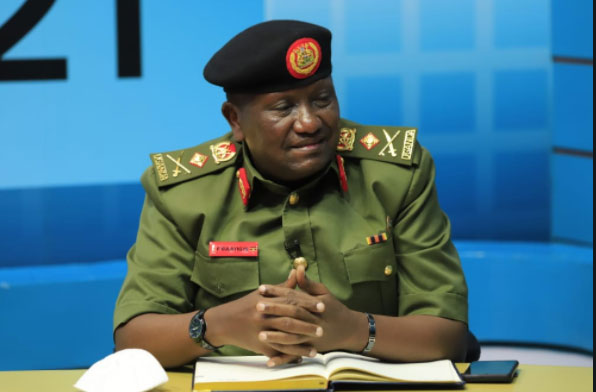
But UPDF spokesperson, Brig. Felix Kulaigye on Feb.15 issued a statement describing Mulumba’s accusations as falsehoods. Kulayigye said UPDF soldiers have never stepped in Sake and accused Mulumba of using photos of UPDF soldiers when they were on a legally sanction East African Community Regional Force (EACRF) peacekeeping mission in 2023 in an area called Tchengerero, along Bunagana-Rutshuru road in Rutshuru territory.
“Mulumba, who is actually the spokesperson for Democratic Forces For Liberation of Rwanda (FDLR) aka Wazalendo, and they are trying to justify their losses to M23 with such allegations,” Kulayigye said.
Although Kulayigye appears to wrongly treat FDLR as the same as Wazalendo, shortly after he released the statement, Mulumba released another statement saying the UPDF was treating them as “fools”.
“And this is how they treat the Congolese as fools, here they are denying the evidence seen and experienced by the Congolese as well as the Ugandans on both sides of the border,” he said. These statement appear designed to intensify speculation that the UPDF is involved in fighting on the side of M23.
Increased fighting
The accusation of UPDF involvement come as the Allied Democratic Forces (ADF), a rebel movement based in Eastern DRC but fighting the Uganda government, has extended their area of influence into North Kivu province.
Records since 2023 indicate that despite continuing joint operations by Congolese and Ugandan armed forces, between April 01 and September 10, 2023, the ADF reportedly carried out 101 attacks, killing 406 civilians, including 56 women and 53 children, in Ituri and North Kivu Provinces.
Also protests erupted in Bunia, the capital of Ituri province, on April 20 over the perceived limited impact of Operation Shujaa conducted by Congolese and Ugandan armed forces against ADF, and the state of siege, in place since May 2021.
On June 17, 2023, alleged ADF elements also attacked a school in Mpondwe, western Uganda, near the Congolese border. The attack resulted in 42 deaths, six injuries and the kidnapping of six students.
Following the escalation, the DRC government in September 2023 allowed the joint operations between the Ugandan army and FARDC to expand to new areas in order to go after fleeing ADF fighters. The new deployment was to go up to the territory of Mambasa in Ituri province.
Operation Shuja was launched in 2021 as a joint offensive between the UPDF and the Congolese army against the ADF.
In the past two or so years, the operations has seen over 500 ADF fighters killed and many others either captured or surrendered. A number of ADF captives have also been rescued.
A report of the Group of Experts on the DRC says ADF has recently received financial support from the Da’esh terrorist group and collaborated with Da’esh cells in South Africa, suggesting a growing threat of terrorism in the region.
On 8 August, alleged ADF combatants renewed on social media their pledge of allegiance to the new leader of Da’esh, Abu Hafs al-Hashimi al-Qurashi.
Effect of regional force departure
The Masisi, Rutshuru territories are a historically militia plagued and ungovernable areas. In fact, the Independent National Electoral Commission (CENI) of the DR Congo failed to carry out identification and registration operations of voters in the territories for the just concluded election in which President Tshisekedi was re-elected.
Instead the CENI on Jan. 31 released a rescheduled calendar for the operation in the territories which will be in July.
But the current fighting started in March 2022, when M23 leader Bertrand Bisimwa and Commander Gen. Sultan Makenga relaunched a war against the government.
There has recently been escalation in fighting between M23 rebel forces and those of the Congolese army (FARDC) and its allies has been raging since the intervention forces of the East African Community Regional Force (EACRF) withdrew from the area starting in late December 2023.
Heavy fighting erupted as soon as the first batch of about 300 soldiers withdrew from the area on orders of the DRC government which accused them of failing to fight the M23 and restore its authority in the area.
The mandate of troops from Uganda, Kenya, Burundi and South Sudan deployed in North Kivu province in late 2022 was to reclaim positions that were previously held by the M23 rebels after they defeated the government army FARDC and to establish a buffer zone to prevent further clashes between M23 rebels and FARDC soldiers.
This is in accordance to resolutions made and approved by the East African Regional Heads of State Conclave held on April, 21 2022 in Nairobi, Extra Ordinary Summit of East African presidents (Bujumbura) on February 4, 2023, and the decisions of the Chief of Defense Forces of February 9, 2023 in Nairobi.
The United Nations Organisation Stabilisation Mission in the Democratic Republic of the Congo (MONUSCO) has also been kicked out and has been withdrawal its mission in the country since June 2023.
This is a major move because the UN peacekeeping mission has been present in the country since 1999. It is one of the largest and most expensive in the world, with an annual budget of around 1 billion dollars.
It appears, to fill the vacuum left by both the UN and East Africa regional force, President Tshisekedi’s plan is to work with rather than fight the militias. As part of the plan, he also aims to invoke a spirit of nationalism and labelling the M23 as a foreign proxy force is party of the strategy.
A coalition of forces of the Kinshasa government, namely the national army FARDC, the rebel Democratic Forces for the Liberation of Rwanda (FDLR), the Wazalendo militias, and soldiers of the South African National Defence Force (SANDF) were involved in the fighting.
According to reports, the fighting erupted in Kilorirwe, Karenga, Kabati, Rumeneti and their surroundings in Masisi territory. The M23 rebels were reportedly seen at Kagoma hill in the village of Malehe and the government army coalition shelled their positions from Kiabati-kingi. Since then, it appears, the M23 has been able to rout the coalition forces and gain territory to the extent of threatening Goma, the main city in the area.
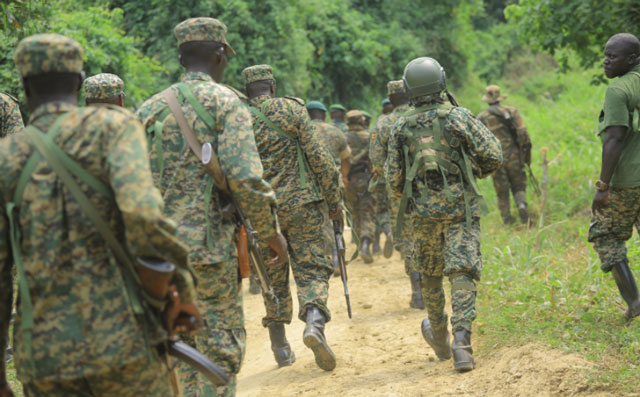
UPDF gets sucked in
Previously, and on the record, the DRC government has always accused the Kigali government of President Paul Kagame of militarily backing the M23 rebel group.
But attempting to drag the Uganda army into the conflict between the M23 and the pro-government forces in the DR Congo on one hand and the M23-origin theories on the other is a hot-wire because it has on two previous occasions resulted major conflagrations in the Great Lakes Region.
This includes the so-called `Africa’s World War’ which started in August 1998 when the Banyamulenge in Goma erupted into rebellion and ended in July 2003, a few months after Joseph Kabila was sworn in as head of the Transitional Government of the Democratic Republic of Congo.
Historically, the M23 refers to the “March 23 Movement” because on March 23, 2009, the Congolese Tutsi-led rebel group, the National Congress for the Defence of the People (CNDP) signed a peace treaty with the DRC government which among others, offered its fighters the chance to be integrated into the national army. But this did not happen.
Several forces, including Rwanda, have been eager to remind those making the accusation that M23, in fact, should be linked more closely to Uganda because that is where many of its members regrouped following their defeat in 2013.
The M23 was formed on April 4, 2012 when nearly 300 soldiers – the majority of them former CNDP members revolted against the DRC government, citing poor conditions in the army and the government’s unwillingness to implement the March 23, 2009 peace deal.
Its leader was Bosco Ntaganda, also known as “The Terminator” who was a former members of the Rwandan Patriotic Forces.
The M23 rebels captured Goma, the capital of North Kivu province in a major escalation of conflict that saw MONUSCO helicopter gunships deployed to support government forces. The M23 also defeated a counterattack by the government forces. Almost 3,000 members of the Congolese army and police forces switched sides in Goma on 20 November and joined the rebellion as M23 continued its advance, seizing control of the town of Sake and stating that it intends to overthrow the national government According to UNHCR, over 140,000 people fled their homes at this time.
But the situation escalated fast when the M23 agreed to withdraw from Goma on their own. This deal was reportedly brokered by a Uganda government team led by then-UPDF Chief of Defence Forces, Gen. Aronda Nyakairima. The M23 left Goma city in early December 2012 but the fighting did not stop.
On February 24, 2013, eleven African nations, including Uganda and Rwanda, signed an agreement designed to bring peace to the region. Then in October 2013, Congo told the UN that the M23 movement was virtually finished after being pushed back to a small area near Rwanda. And on November7, 2013, following significant defeats, M23 troops crossed into Uganda, surrendered, and about 1,400 of them were cantoned in the Bihanga Military Training School in Ibanda District.
But in January 2017, the M23 rebels crossed back into the DR Congo, sparking fears of a new armed rebellion and yet more humanitarian suffering in a region long used to violence.
At the time, the DR Congo government said hundreds of armed ex-M23 fighters, supposedly exiled in Uganda, had re-emerged in North Kivu Province.
“We are disappointed with our Ugandan colleagues for letting these criminals out, moreover armed,” said Government spokesman Lambert Mende Omalanga. “We can’t allow this (destabilization) to happen.”
A new confrontation immediately ensued at the border town of Ishasha on January 14, 2017.
Then-government spokesman Ofwono Opondo said not all but some ex-M23 rebels had “escaped” from Bihanga.
“They have lately and quietly been escaping in small groups of about five into the general public, and some to unknown places,” he told the UN news agency, IRIN.
Uganda insisted it was not involved in the escape of the rebels and is in no way backing another rebellion.
“These are individuals who are escaping on their own,” said Opondo. “Uganda will not and does not support any armed activities to destabilise the DRC.”
In fact, on January 18, 2017, the Ugandan military reported it had apprehended a group of 101 former M23 rebels in Uganda’s western towns of Mbarara and Kabale. It said they were disguised as civilians en route to Congo.
But President Yoweri Museveni continued to publically urge Kinshasa to honour its commitments to the M23 as a way of ending the mistrust between it and the M23 rebels.
“We can’t be blamed for the failed repatriation of these people,” said Opondo, the Ugandan government spokesman. “We want them out. We have always asked the DRC government to take them back. But they (authorities) seem unwilling and failed to convince them.”
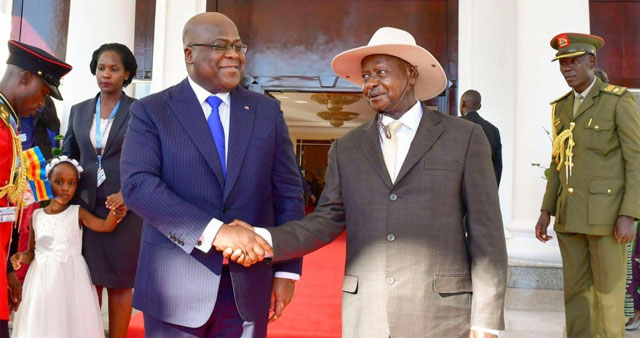
A senior M23 official, who asked not to be identified, reportedly told IRIN the mass escape was a direct result of the Congolese government dragging its feet over its pledges and failing to provide the necessary security guarantees to convince the ex-rebels to return.
“These combatants have been in Bihanga for over three years without knowing their next fate. (President Joseph) Kabila has failed to honour the implementation of the Nairobi Declarations and Addis Ababa Agreements for their return and reintegration,” the M23 source said.
“As Congolese citizens, they have a right to go back home without informing anybody,” the source added, denying however that they had returned armed.
Meanwhile other efforts to end the conflict through dialogue continue, including by the UN. In December 2023, Huang Xia, the Special Envoy of the Secretary-General of the United Nations for the Great Lakes Region convened another meeting on the issue in Kampala.
Speaking at the opening of the second retreat of the High-Level Political Group of the United Nations Regional Strategy for the Great Lakes Region at Sheraton Hotel, Kampala, Xia announced a revitalised commitment by regional states to resolve the conflict through the Peace, Security, and Cooperation Framework for the Democratic Republic of Congo and the region, initially signed in 2013. He said the signatory countries have reaffirmed their dedication to adhere strictly to the framework.
The signatories to the framework comprise Angola, Burundi, Central African Republic, Congo, Democratic Republic of the Congo, Rwanda, South Africa, South Sudan, Tanzania, Uganda, and Zambia. The overseeing entities include the UN, Belgium, and the United States of America.
The framework entails commitments such as refraining from interfering in neighbouring countries’ internal affairs, neither tolerating nor aiding armed groups, respecting sovereignty and territorial integrity, and denying harbor or protection to individuals accused of war crimes or under UN sanctions, among other stipulations. These are the accusation against Uganda and Rwanda in regard to the M23.
 The Independent Uganda: You get the Truth we Pay the Price
The Independent Uganda: You get the Truth we Pay the Price

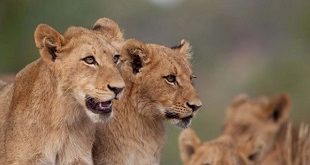


DRC needs prayers just.
Unfortunately, we can’t choose our neighbours.
But it’s becoming increasingly clear that it was a big mistake to rush the expansion of the East African Community to include countries beyond the original three member states.
DRC, Rwanda, and Burundi would have formed their own community and they resolve their common issues among themselves.
South Sudan, Sudan, Central African Republic, and Chad would have formed their own community.
Somalia, Ethiopia, Eritea, and Djibouti would have formed their own community.
Then, when those communities have fixed their things, a brand new entity of all those communities plus the original East African Community would be formed… and by that time, all of these regional issues will have been resolved among member states of the smaller communities before we can talk of development and moving forward as a region and as a continent.
See now the kind of thing EAC has become because of rushing to include more members before they have fixed their things.
What can the EAC possibly achieve after bringing in all these new members with so many major unresolved issues? The fact that they don’t even want to sit down together and resolve those issues is perhaps the most alarming part of the problem.
In the meantime, millions of innocent Africans continue suffering and dying, and the continent keeps moving backwards, because of poor leadership that makes a mockery of pan africanism.